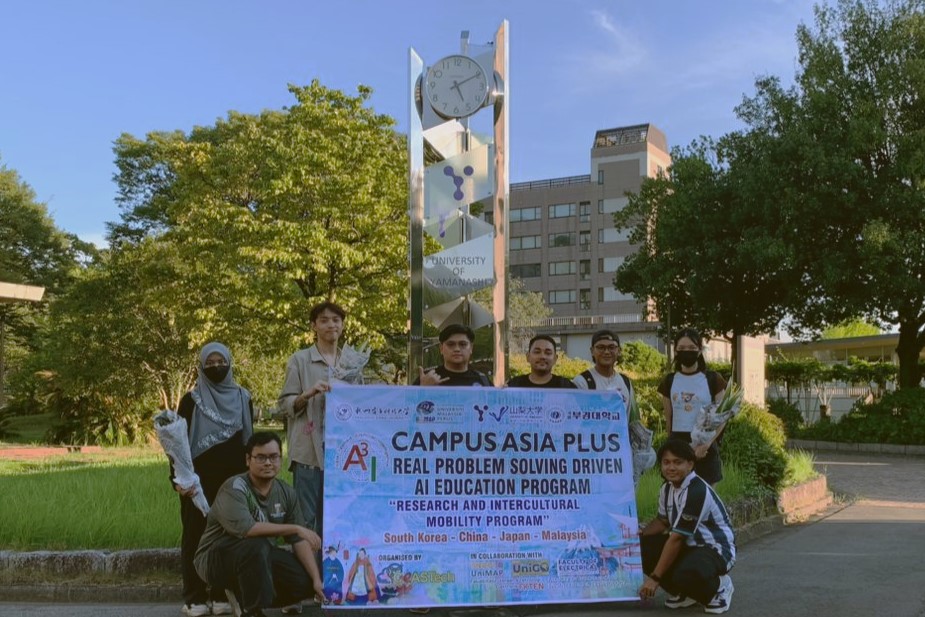UNIVERSITY OF YAMANASHI SHORT PROGRAM AUGUST 2023
The Short Program was held from 17th – 31st August 2023, at University of Yamanashi, Japan.

The Short Program was held from 17th – 31st August 2023, at University of Yamanashi, Japan.

Professor Hiromitsu Nishizaki conducts an orientation and games. There was an introduction to the history of the University of Yamanashi, architecture, and presence departments in UY. Prof. Nishizaki conducted a True or False game based on general knowledge of Japan. In the evening, a Campus Tour was conducted to allow the participants to explore the facilities at UY. We visited Satoshi Omura Museum, UY Library, International Affair Office, Nanomaterial Research Centre, and Kogyou Kaikan.
Amemiya-san as our tourist guide introduced us to several Historical Places around Kofu. The first place is Takeda Jinja or Takeda Shrine. We learned about the architecture of a shrine such as Torii (main gate), Komainu (guardian lion-dogs), Temizuya (purification fountain), and Worship Hall. We visited Takeda Family cemeteries, Ote-seki rui (stone fort), Tomb of Takeda Shingen, and Lady Sanjo. There are a lot of historical value of Shintoism influences on Japanese Culture.
This class focused on how to survive in Kofu and know several phrases to get services in Kofu. They learned how to use public transport, asked the directions, mannerisms and culture in Japan, and many more. Wagashi workshops were conducted by Takatoshi Furuya Sensei. Wagashi is a term for traditional Japanese confections that are usually served with green tea. They can be made from natural, plant-based ingredients such as rice flour, beans, and agar. They can have different forms, consistencies, flavors, and regional or seasonal variations. They also learned how to make a Matcha and the etiquette to consume the tea. Matcha is a type of green tea made from the powdered leaves of the Camellia sinensis plant. It is traditionally served at tea ceremonies in Japan and is now widely available and used in cooking. Matcha is different from regular green tea as it is grown differently..
The first trip is to Oshino Hakkai a scenic park with ponds that come from drinkable natural mineral water. Next they had lunch at Uoyoshi Kaikan, a Muslim-friendly restaurant near the Mt Fuji area. They were served with Vegetable Fried Rice, Shrimp Tempura, diced chicken many more. Their next stop is Oishi Park. Thery were divided into two groups, one group experienced a traditional art craft in the Japanese Craft Centre in the same area while the other group was given free times to take a walk in Oishi Park. In the craft center, they were given the opportunity to make a Shibori. Shibori is a traditional Japanese dyeing technique that creates patterns on fabric using manual resist dyeing. The word “shibori” means “to wring” or “to squeeze” in Japanese. It originated during the early Edo period in Japan (1603 to 1868) and is a predecessor to tie-dyeing. The technique involves manipulating fabric in various ways before dyeing it, using techniques such as folding, twisting, binding, and stitching. Lastly, they visited a winery farm called Miyakouen. We learned the history architecture and facilities of the winery building.
Awaji Sensei conducts a Furoshiki workshop in the morning. Furoshiki is a traditional Japanese wrapping cloth that is eco-friendly and mostly used for wrapping gifts, carrying goods, or just as a décor accessory. A yukata is essentially a lightweight form of kimono, which is worn casually during the summer. They are made from thinner, lighter material than the traditional silk kimono, which makes them more comfortable in the hot weather, and easier to wash. Yukata are usually made of lightweight cotton or linen and are typically printed with colorful designs, such as flowers or geometric patterns. They are worn with an obi, or sash, around the waist. Yukata can be worn by both men and women and are usually seen during the summer months
Koto is a traditional Japanese musical instrument that belongs to the zither family. It is a long zither with movable bridges and usually has 13 strings. They were divided into two groups, Group A went to experience Ikebana conducted by Atobe Sensei, and Group B to a Koto Session taught by a professional Koto player, Sakamoto Sensei.
An Artificial Intelligence-based workshop was conducted from the morning. This workshop required us to brainstorm several fresh ideas on the application of AI that will benefit society. It was a compelling experience as we were able to express our opinions and experiences associated with our own cultures and countries.
A farewell party was held in the evening as the last event of this program. It was a very memorable day for each of them as it was their last day to see each other. They were provided with a variety of delicious dishes and they ended the party by watching a video that captured every moment we spent together along this journey. Mr. Nonumura gave a toast speech for our last day together and as a token of recognition, Professor Hirmoitsu Nishizaki presented each of them with a certificate of participation, underscoring their valuable contribution to the program.



